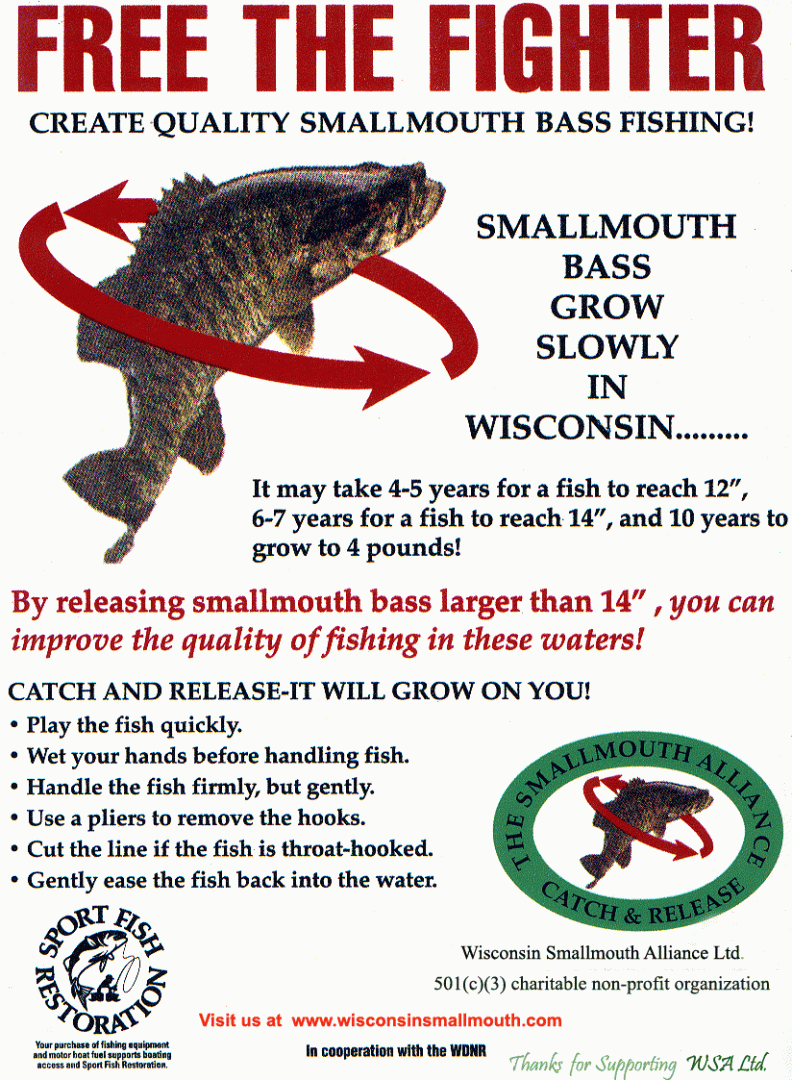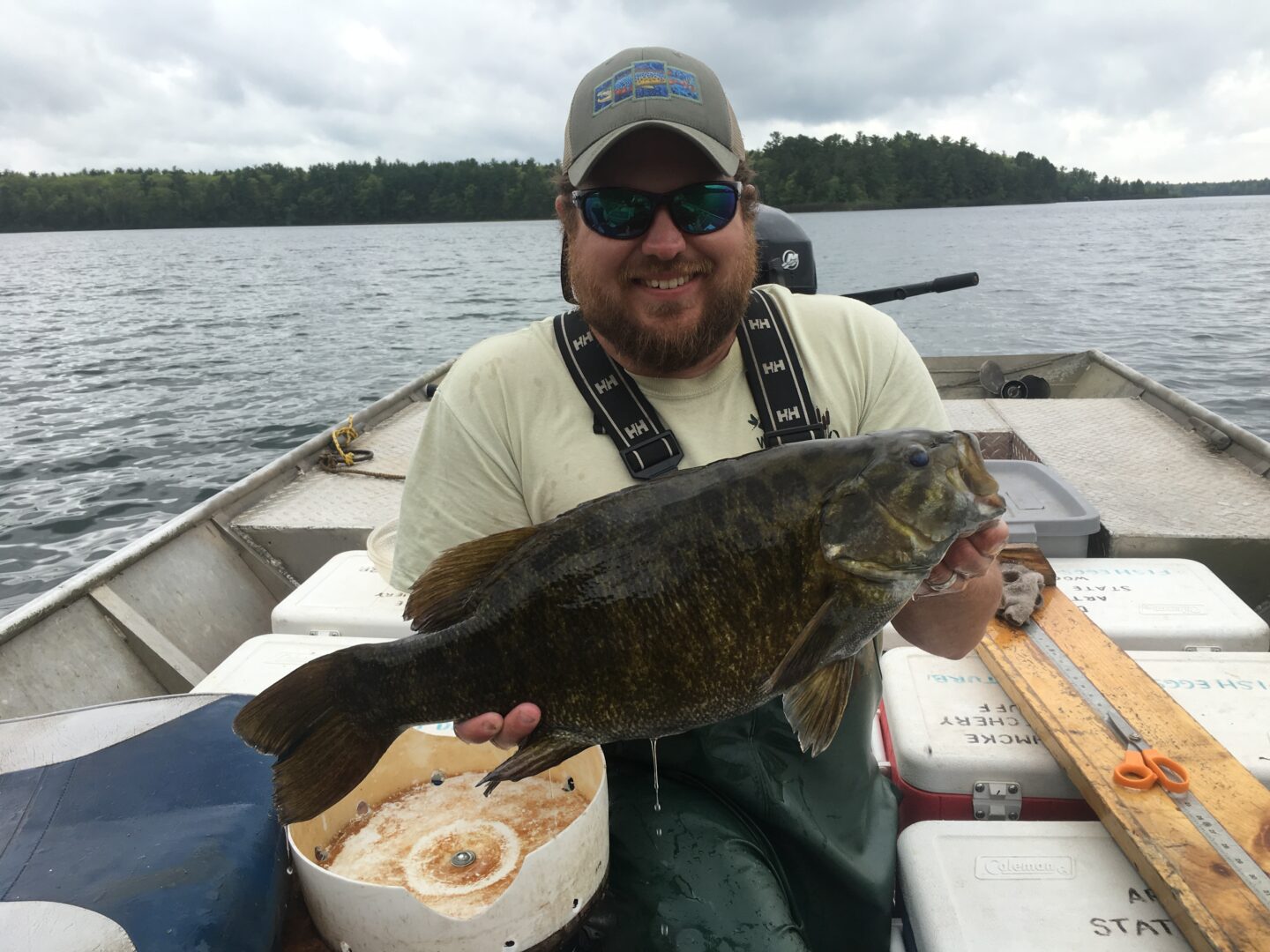
Wisconsn leads the way in trophy bass production. Vilas County biologist, Steve Gilbert, lifts a pair of 20 inchers that were sampled in 2016. / Photograph Steve Gilbert
INTRODUCTION – The contents of this page are excerpts from the current Wisconsin Bass Management Plan, a 15 year old document. CLICK HERE TO READ PAMPHLET (2001).
Wisconsin has a wide variety of anglers who enjoy bass fishing. Many of us have a wide range of opinions on how to best manage bass. Many of us want to see trophy regulations (18-1 lakes) or pro-longed catch and release seasons implemented on lakes that are displaying trophy size structures of fish but aren’t being managed as such. Big fish deserve protection.
A single management strategy will not meet the desires of all anglers. Therefore, Wisconsin believes it is important to provide a variety of fishing opportunities by managing groups of waters for specific fishery objectives. However, a diversity of fishing opportunities must be balanced with concerns of increasing complexity of regulations.
I’ve discussed with state biologists whether a modern plan will be published for inland waters and if smallmouths can receive management separation from largemouths, and more trophy regulations like the types enacted on Great Lakes waters, and a fall catch and release season similar to Minnesota's. It can happen, but it will require a grassroots movement by those who want it in order to push it thru the system.
17 years later we have so many big fish in many lakes that are deserving of better bass regulations. Per my sources, the statewide bass committee is in the process of updating the WI bass management plan. A new team leader is being appointed and I hope to find out more.
 This is a 22.8 inch fish DNR crews netted in 2016. "Biggest one that any of our crews have captured in this area in the 25 years I’ve been here," says Steve Gilbert. / Photograph by Steve Gilbert.
This is a 22.8 inch fish DNR crews netted in 2016. "Biggest one that any of our crews have captured in this area in the 25 years I’ve been here," says Steve Gilbert. / Photograph by Steve Gilbert.
The Bass Management Team (BMT) was formed at the direction of the Natural Resources Board (January 1996) to address concerns with the early catch and release season in the northern zone, review and evaluate current management practices, and develop recommendations that would simplify existing bass regulations while maintaining a conservative approach to bass management. The Team met seven times between June 1996 and October 1998 to identify and analyze issues, formulate statewide bass management goals, develop specific objectives and strategies with the highest priority being to resolve issues related to the early catch-and-release season in the northern zone, to revise bass stocking strategies, and to develop a framework for bass regulations.
The purpose of this plan is to increase quality bass fishing opportunities in Wisconsin by protecting and enhancing existing bass populations and the environmental conditions upon which they depend, and by improving technical information and outreach, in full partnership with the anglers of the state. The following goals were developed to guide the department in meeting this vision:
-
Protect, restore, and enhance habitat on Wisconsin waters.
-
Ensure that adequate technical information is available for Wisconsin’s bass fisheries.
-
Protect and maintain Wisconsin’s self-sustained bass fisheries and associated fish assemblages and aquatic communities.
-
Communicate with anglers and promote the recreational value of Wisconsin’s black bass fisheries.
-
Provide a variety of quality bass fishing opportunities within a flexible management system.
BACKGROUND INFORMATION
The smallmouth bass also occurs in all Wisconsin basins; its distribution has not changed substantially since the turn of the century, even though considerable transfer and stocking efforts have occurred over the years. Over 3,500 miles of stream contain smallmouth bass. The smallmouth is common in medium to large streams with abundant cover and shade and in large, deep (average depth > 9 m), clear lakes throughout Wisconsin, as well as in upper Green Bay of Lake Michigan and Chequamegon Bay of Lake Superior. In rivers, adults are present in moderate to swift currents associated with rocky substrate (>45%), while young-of-year occur in eddies along the banks and are associated with cover (e.g.,vegetation, rubble, banks, or other woody cover) because they generally avoid open water. In lakes, smallmouth bass are strongly associated with cover over rocky or sandy substrate; lakes over 20 feet deep, with rooted aquatic vegetation and clean, gravel shores with abundant cover provide optimum habitat. It often occurs near rock ledges and rocky bottoms, but may also be found along weedy shorelines. Smallmouth bass occur most consistently in shallow, near-shore waters (<15 feet deep) except during winter, when they generally remain in deep pools (rivers) or deeper areas of lakes. In rivers, smallmouth bass can migrate long distances seasonally, so habitat requirements vary spatially and temporally; unregulated rivers appear to be critical to smallmouth bass. Sedimentation is a major habitat factor in the viability of smallmouth bass populations.
Preferred bass spawning substrate is gravel, but spawning occurs on a variety of other materials, ranging from sand to plant fibers and roots or other exposed hard surfaces in otherwise soft muck or silt substrate. Water depth over nests averages about 2 feet. In waters containing both species, largemouth bass spawn earlier than smallmouth bass in shallower, protected spawning sites among emergent vegetation in quiet bays. Young bass remain in the nest for 6 to 15 days, after which they school together near the nest site for 10 to 28 days and then disperse throughout the shoreline. Predation is heavy during this period, so near-shore cover is important for survival of young bass.
Smallmouth bass spawn on rocky shoals, river shallows, or backwaters or move into tributaries to spawn. The species requires clean rock or gravel substrate for spawning. In lakes, smallmouth bass build nests first on the west and north shorelines, where waters warm faster and they are protected from prevailing winds. Nests are generally constructed on gravel and rubble, preferably beside a large obstructions such as a boulders or logs. Excessive siltation on fertilized eggs will result in parental abandonment and nest failure.
Clearly, littoral habitats with abundant cover (vegetation, rock, woody structure) and a variety of substrates, including rocky bottoms with very little deposition of fine sediments are crucial for both species. “Half-logs” have been used successfully to improve spawning cover for smallmouth bass in lakes lacking large woody structure such as downed trees (Hoff 1991).
SUPPORT FOR A REVISED MODERN PLAN AND FURTHER PROTECTION
-
More recent studies have also been conducted to examine the impacts of angling on nesting bass. Kieffer et al. (1995) found that smallmouth bass hooked and played to exhaustion took four times longer to return to their nests than did fish played briefly and released, resulting in a higher probability of nest failure.
-
Closed fishing seasons are common management strategies for many states in the northern tier of the United State and for Canadian Provinces. The shorter growing season in more northern states and provinces apparently results in lower productivity of bass populations.
-
Years of liberal seasons, length limits and bag limits, coupled with the increase in licensed anglers, resulted in a decline in the quality of many of bass fisheries.
-
In 1994, the Department was again asked by tourism interests from the northwest to review the possibility of allowing the harvest of 1 bass per day, provided it was 18" or longer. A survey of Fisheries Biologists revealed opposition to this change because it was thought that the larger fish, which were intended for protection under the catch-and-release season, would be targeted. Ultimately, dissatisfaction with the rule in northwest Wisconsin resulted in a reduction in the size of the northern zone.
-
Estimates of bass harvest during May and June in the years prior to the early catch-and- release season indicated that up to 36% of the harvest occurred prior to June 20. However, many of the bass saved during the early season are probably harvested later in the year.
-
Elimination of the early catch-and-release season would eliminate the need for "zones", which would greatly simplify bass regulations with no harm to bass populations. Opening the bass season on the same date statewide would decrease confusion among anglers and provide a "level playing field" for fishing-related businesses.

FREE THE FIGHTER
-
It takes approximately 20 years to grow a 20 inch smallmouth bass. Anglers continue to release big fish so they can keep growing. Catches challenging the current Wisconsin state record are happening now more than ever before!
-
With proper handling, quick hook removal and rapid return into the water, the survival rate of bass is typically quite high.
-
We want smallmouths to protect their nests. Catching fish during spawning can greatly reduce the number of eggs and fry that survive. Catching fish off of beds, and stressing them out by overplaying and overhandling can reduce spawning success and a return to the bed. Immediately releasing fish and minimizing play will help reduce this effect. Avoid using nets altogether during the spawning period.
-
Who the hell eats smallmouths?


